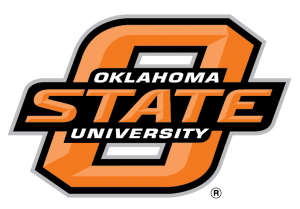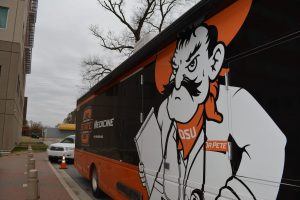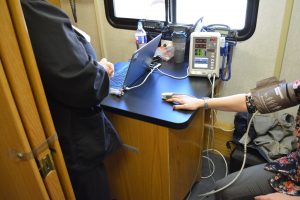OneNet Connectivity Powers OSU-CHS Mobile Telemedicine Clinics
 Oklahoma State University Center for Health Sciences (OSU-CHS) is tackling Oklahoma’s health care obstacles straight on. Through numerous initiatives, leaders at OSU-CHS are addressing health and educational concerns as well as medical professional shortages.
Oklahoma State University Center for Health Sciences (OSU-CHS) is tackling Oklahoma’s health care obstacles straight on. Through numerous initiatives, leaders at OSU-CHS are addressing health and educational concerns as well as medical professional shortages.
One of these obstacles is the lack of health care services available to rural Oklahomans. Most small communities lack specialists, and in some cases, any medical professionals at all. To help solve this problem, OSU-CHS has created a mobile telemedicine program designed to meet the needs of these residents using a bus and a secure OneNet internet connection at OSU-CHS in Tulsa.
For Oklahomans in large cities, doctor offices are relatively accessible and patients needing specialist care are referred to a professional within their community. For rural residents, this might not always be the case.
“We still find that access to health care is really difficult across the state, especially in small towns,” said OSU-CHS interim assistant dean for clinical education and simulation medicine, Dr. Joseph Johnson. “They don’t have the income, transportation or the wherewithal to make it into larger cities.”
Watch our video to learn about OneNet’s partnership with OSU-CHS
To help these rural residents gain access to the same professional level of treatment while maintaining the one-on-one relationship between doctor and patient, leaders developed the concept for the mobile telemedicine clinic in 2014.
 The telemedicine bus is essentially a doctor’s office on wheels. OSU-CHS has two buses that make weekly or monthly trips to communities in northeastern and western Oklahoma. Residents in these areas can make appointments to visit with the onboard medical professionals or walk-in.
The telemedicine bus is essentially a doctor’s office on wheels. OSU-CHS has two buses that make weekly or monthly trips to communities in northeastern and western Oklahoma. Residents in these areas can make appointments to visit with the onboard medical professionals or walk-in.
If needed, the telemedicine bus is equipped with imaging software that allows specialists in Tulsa to communicate with the patient while conducting an exam with the help of the onboard medical professional. Through a secure OneNet internet connection, the specialist in Tulsa can view the patient’s EKG, sonogram and other necessary diagnosis resources in real time to make recommendations.
Reliable and clear connections are essential for the specialist to adequately view and communicate with their patient on the bus, which is why Dr. Johnson says OneNet’s connectivity is crucial.
“Nothing runs without the high-tech infrastructure OneNet provides us,” he said. “OneNet enables this project to happen.”

A patient has her blood pressure checked on a visit to the telemedicine bus.
Shannon Russell, a Geary resident, frequently uses the telemedicine bus, which parks two blocks away from her house every Tuesday. With only one vehicle for her and her husband to share, Russell has easy access to medical care for herself and her children.
Russell is just one of many patients the telemedicine bus serves weekly in Geary. The nearest hospital is 20 miles away, making it difficult to access for residents without vehicles or the resources to make the trip.
“OneNet’s robust connectivity has enabled leaders at OSU-CHS to create this innovative solution,” said OneNet executive director, Vonley Royal. “Oklahoma’s higher education institutes are taking the technological resources we offer and changing not only the future of our state but also the globe.”
Johnson believes that programs like the mobile telemedicine clinic will help doctors address health care concerns of citizens early on, thereby avoiding greater health and financial costs.
“It’s not only savings lives,” he said. “It’s improving the quality of lives and decreasing the state’s health care burden. It’s a win-win all-around.”
Story by Alexandra Franklin
